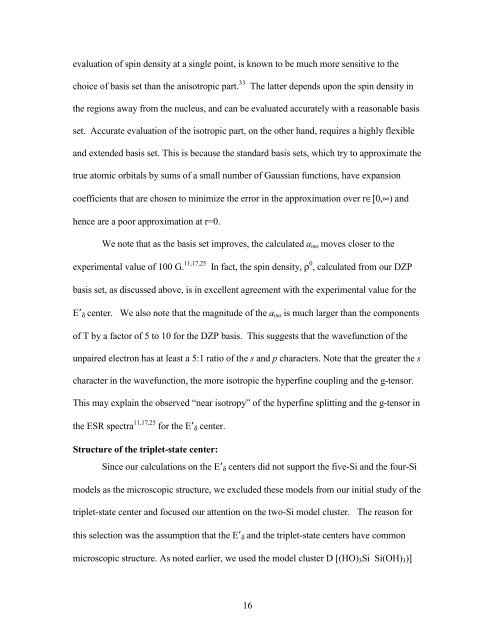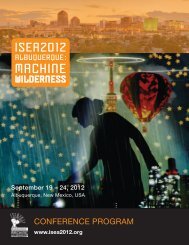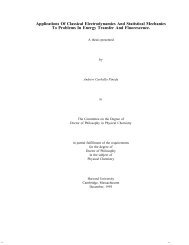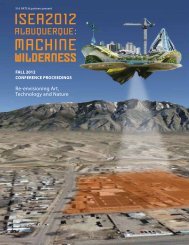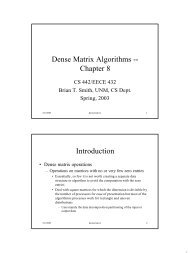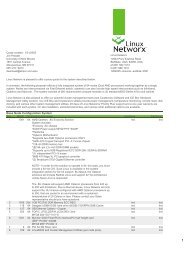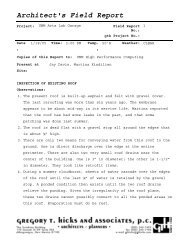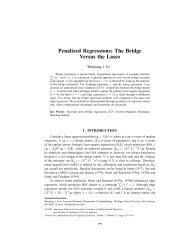Electronic Structure Theory of Radiation-Induced Defects in Si/SiO2
Electronic Structure Theory of Radiation-Induced Defects in Si/SiO2
Electronic Structure Theory of Radiation-Induced Defects in Si/SiO2
Create successful ePaper yourself
Turn your PDF publications into a flip-book with our unique Google optimized e-Paper software.
evaluation <strong>of</strong> sp<strong>in</strong> density at a s<strong>in</strong>gle po<strong>in</strong>t, is known to be much more sensitive to the<br />
choice <strong>of</strong> basis set than the anisotropic part. 33 The latter depends upon the sp<strong>in</strong> density <strong>in</strong><br />
the regions away from the nucleus, and can be evaluated accurately with a reasonable basis<br />
set. Accurate evaluation <strong>of</strong> the isotropic part, on the other hand, requires a highly flexible<br />
and extended basis set. This is because the standard basis sets, which try to approximate the<br />
true atomic orbitals by sums <strong>of</strong> a small number <strong>of</strong> Gaussian functions, have expansion<br />
coefficients that are chosen to m<strong>in</strong>imize the error <strong>in</strong> the approximation over r∈[0,∞) and<br />
hence are a poor approximation at r=0.<br />
We note that as the basis set improves, the calculated a iso moves closer to the<br />
experimental value <strong>of</strong> 100 G. 11,17,25 In fact, the sp<strong>in</strong> density, ρ 0 , calculated from our DZP<br />
basis set, as discussed above, is <strong>in</strong> excellent agreement with the experimental value for the<br />
E’ δ center. We also note that the magnitude <strong>of</strong> the a iso is much larger than the components<br />
<strong>of</strong> T by a factor <strong>of</strong> 5 to 10 for the DZP basis. This suggests that the wavefunction <strong>of</strong> the<br />
unpaired electron has at least a 5:1 ratio <strong>of</strong> the s and p characters. Note that the greater the s<br />
character <strong>in</strong> the wavefunction, the more isotropic the hyperf<strong>in</strong>e coupl<strong>in</strong>g and the g-tensor.<br />
This may expla<strong>in</strong> the observed “near isotropy” <strong>of</strong> the hyperf<strong>in</strong>e splitt<strong>in</strong>g and the g-tensor <strong>in</strong><br />
the ESR spectra 11,17,25 for the E’ δ center.<br />
<strong>Structure</strong> <strong>of</strong> the triplet-state center:<br />
S<strong>in</strong>ce our calculations on the E’ δ centers did not support the five-<strong>Si</strong> and the four-<strong>Si</strong><br />
models as the microscopic structure, we excluded these models from our <strong>in</strong>itial study <strong>of</strong> the<br />
triplet-state center and focused our attention on the two-<strong>Si</strong> model cluster. The reason for<br />
this selection was the assumption that the E’ δ and the triplet-state centers have common<br />
microscopic structure. As noted earlier, we used the model cluster D [(HO) 3 <strong>Si</strong> <strong>Si</strong>(OH) 3 )]<br />
16


